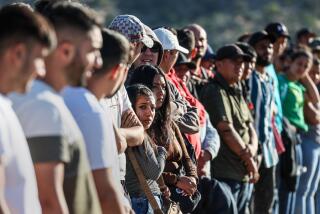America and the New Immigrant Experience : World-Class Tensions: Ethnic Rivalry Heats Up Southern California
Los Angeles is in a violent confrontation with itself. Escalating inter-ethnic conflicts are frustrating its effort to become a world-class city.
Development policies over the last decade have sought to make the Los Angeles area the magnet of the burgeoning Pacific Rim economy. The regionâs growth has been phenomenal, as measured by trade revenues, number of building permits issued and aggregate income. The success of Los Angelesâ integration into the international economy, however, is not matched by success in integrating its immigrant and ethnic minority populations.
The Los Angeles area--indeed, all of California--has also seen phenomenal growth in its immigrant communities. Most of the new immigrants are from Asia, Mexico and Central America--from countries torn by war and chronic undevelopment. In large part, they are drawn here by the same promise that has drawn foreign business investors: economic opportunity. But the recent increase of inter-ethnic interactions ending in tragedy suggests that we are poorly prepared to cope with the cityâs increased diversity.
The consciousness of Los Angeles was was shocked recently by the killing of a 15-year-old African-American schoolgirl by a Korean merchant. African-American and Latino relations came to the boiling-over point at a local high school. Latino-Cambodian tensions in Long Beach have erupted into unbridled urban warfare. Innocent children are dying almost daily in minority gangsâ quest for neighborhood control. Racial supremacists are coming out of the closet, and hate crimes are setting new records.
All signs point, regrettably, to the continuing escalation of these conflicts and human tragedies. For Los Angeles remains the most racially segregated city in the country.
Long separated by distance and custom from the cityâs middle-class residential communities, South-Central Los Angeles has become the magnet--and launching pad--for impoverished immigrants. For decades South-Central was virtually all African-American; today, it has a rapidly growing Latino population and its neighborhood merchants are increasingly immigrant Asians. But unlike the âinvasion/successionâ (white flight) of the 1950s, African-Americans have neither the motive nor the means to move out. And they have grown resentful of other ethnic groups âmaking itâ in America--at their expense. The opening of another Korean store in South-Central is like pouring salt into the wounds of decades of economic dependency.
Economic tensions are also infected by mutually shared stereotypes and intolerances. Newcomers to African-American communities often harbor the racial ideology of black inferiority that permeates the popular culture here and in many of the immigrantsâ homelands. African-Americans may be quick to ridicule or take offense at the cultural and linguistic practices of Latino neighbors and Asian merchants. Distrust and incomprehension is now a three-way phenomenon.
These groups also compete for limited public resources. African Americans, Asians, and Latinos often find themselves pitted against each other for political representation and a share of public goods and services. Excluded from segregated, upwardly mobile communities, choked by public and private-sector divestment and neglect, South-Central residents live in a breeding ground for inter-ethnic conflict. And this social cancer is spreading throughout the region, even to the heart of the San Fernando Valley, for decades the model of All-American--meaning all-white--suburbia.
How, then, do we meet and overcome these challenges to Americaâs ideal of a free and open society? Is there an antidote for inter-ethnic rivalry, violence and bloodshed?
The crisis of the new immigration forces us to re-examine, and re-affirm, our American democratic ideals and our early melting-pot experiences and put them to work building a world-class, cosmopolitan city.
The key to the restructuring of our social/cultural values must be forged by multiethnic coalitions, such as the Asian Pacific Legal Centerâs plan to offer inter-ethnic relations training. The L.A. Black/Korean Alliance is another positive effort to bridge cultural differences.
But these grass-roots efforts, largely dependent on volunteerism, are insufficient. Inter-ethnic and inter-cultural relationships belong on our local, state and national agendas.
The silver lining in the crises surrounding the new immigration lies in making us acknowledge and confront our prejudices and our societyâs structured inequities. We must find a way of resolving disputes--large and small--nonviolently. We must develop and propagate images in the popular media that reverse stereotypes and offer positive models of cross-cultural interaction and understanding.
On a practical, literally street-level scale, zoning and transportation policies must take human interaction into consideration. Pedestrian-oriented development, encouraging greater contact between merchant and resident, young and old, renter and homeowner, newcomers and old, helps to create a community of tolerance and opportunity. It also promotes land-use efficiency and the cosmopolitan culture needed to sustain Los Angeles as a truly world-class city.
More to Read
Sign up for Essential California
The most important California stories and recommendations in your inbox every morning.
You may occasionally receive promotional content from the Los Angeles Times.










